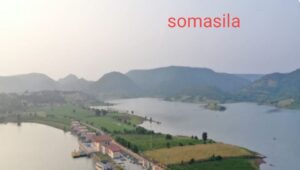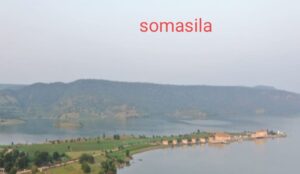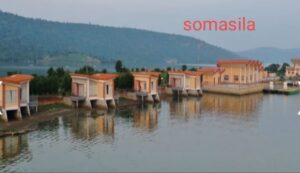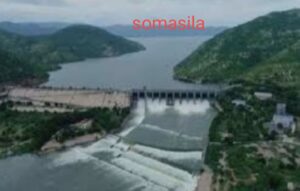Somasila, though historically associated with Andhra Pradesh, is also of interest to Telangana’s tourism. Situated near the border of the two states, it offers a serene retreat for nature enthusiasts and travelers. The picturesque Somasila Reservoir, formed by the Pennar River, provides opportunities for boating, fishing, and other water-based activities. Its lush surroundings and diverse flora and fauna attract those seeking tranquility and natural beauty. While not exclusively under Telangana tourism umbrella, Somalia allure adds to the region’s potential as an emerging destination, encouraging visitors to explore the enchanting landscapes shared between the two states.

1.Historical Significance of Somasila
• Explore the historical background and origins of Somasila.
Somasila holds a rich historical legacy, dating back to ancient times. It finds mention in inscriptions and texts, tracing its origins to dynasties like the Cholas and Satavahanas. The area’s significance in trade routes and cultural exchanges further highlights its historical importance. Over the centuries, Somasila has witnessed the rise and fall of kingdoms, shaping its identity as a historical crossroads. This storied past adds depth to its charm, inviting modern explorers to delve into its captivating history.
• Discuss its role in ancient civilizations and cultures.
Somasila played a pivotal role in shaping ancient civilizations and cultures. The region’s strategic location made it a hub for trade and cultural interactions between various dynasties. The Cholas, Pallavas, and Satavahanas recognized its significance and left their imprints on the landscape through architectural marvels and inscriptions. The reservoir’s waters irrigated fields, facilitating agricultural prosperity and supporting thriving communities. This confluence of water resources and fertile land not only sustained civilizations but also facilitated the exchange of ideas, beliefs, and artistic expressions, contributing to the diverse tapestry of ancient cultures in the area.
• Highlight any historical monuments or artifacts associated with the area.
While Somasila might not boast grand architectural marvels, it possesses its own unique historical charm. The remnants of ancient temples and inscriptions tell stories of bygone eras. The “Someswara Temple,” dedicated to Lord Shiva, stands as a testament to the architectural finesse of its time. Inscriptions found in and around the temple provide insights into the dynasties that once ruled the region. These artifacts offer glimpses into the religious practices, artistic expressions, and societal norms that prevailed in the area, connecting modern visitors with the echoes of history that resonate within Somalia boundaries.

2.Geographical and Ecological Features
• Describe the geographical features of Somasila, including its location, terrain, and surroundings.
Somasila is nestled in the southwestern part of the Nellore district, straddling the border of Andhra Pradesh and Telangana in India. Its geographical location places it amidst a picturesque landscape, surrounded by the Eastern Ghats and lush greenery. The terrain encompasses undulating hills, verdant valleys, and the tranquil waters of the Somasila Reservoir, formed by the Pennar River. The area’s serene ambiance is heightened by its proximity to the expansive Nallamala Forest, adding a touch of wild beauty to the surroundings. These geographical features collectively create a tranquil haven, inviting visitors to immerse themselves in Somalia natural splendor.
• Discuss the ecological diversity and significance of the area.
Somasila boasts remarkable ecological diversity, contributing to its ecological significance. The region’s varied topography, ranging from hills to valleys, fosters diverse habitats for flora and fauna. The Nallamala Forest, adjacent to Somasila, harbors a wealth of plant and animal species, including rare and endemic ones.
Somasila Reservoir’s presence enhances the area’s ecological value by providing a freshwater habitat for aquatic organisms and waterfowl. The reservoir also supports local agriculture through irrigation, furthering the symbiotic relationship between humans and nature.
Conservation efforts are vital to preserve this biodiversity hotspot. By protecting the Nallamala Forest, managing the reservoir sustainably, and promoting responsible tourism, the ecological significance of Somasila can endure for generations, showcasing the delicate balance between nature’s diversity and human interactions.
• Mention any unique flora and fauna found in and around Somasila.
Somalia diverse ecosystem hosts a range of unique flora and fauna. Among its notable flora are the endemic and medicinal plants, some of which have cultural significance. The forests surrounding Somasila are home to species like Sandalwood (Santalum album), known for its fragrant wood and essential oil. Additionally, various wildflowers and grasses contribute to the region’s biodiversity.
In terms of fauna, Somasila provides a habitat for several species of reptiles, amphibians, and avian creatures. The reservoir attracts migratory birds during specific seasons, creating a birdwatcher’s paradise. One might spot Painted Storks (Mycteria leucocephala), Asian Openbill Storks (Anastomus oscitans), and Pelicans (Pelecanus) gracefully gliding over the waters, enhancing the area’s allure for nature enthusiasts.
3.The Creation of Somasila Reservoir
• Explain the process of creating the Somasila Reservoir, including the purpose behind its construction.
The creation of the Somasila Reservoir was a remarkable engineering endeavor that aimed to address multiple needs within the region. The process involved several key steps:
Site Selection: Engineers and hydrologists conducted meticulous surveys to identify an ideal location for the reservoir. The confluence of suitable terrain, river flow, and geological stability led to the selection of the Somasila site.
Diversion and Dam Construction: To impound water and create the reservoir, a dam was constructed across the Pennar River. This involved building a sturdy structure using materials like concrete and stone. The dam’s design ensured it could withstand the pressures exerted by the accumulating water.

Reservoir Formation: As the dam was completed, the river’s flow was diverted to fill the reservoir. Over time, the water levels rose, creating a vast artificial lake that stretched across the landscape.
The primary purposes behind the construction of the Somasila Reservoir were:
Water Storage: One of the main objectives was to create a reliable water storage facility. The reservoir helps store excess water during periods of heavy rainfall, which can then be used during dry spells or droughts. This serves as a critical source of water for various needs, including irrigation, drinking water supply, and industrial usage.
Irrigation: The stored water is released systematically to irrigate agricultural lands downstream. This controlled water release enhances agricultural productivity, enabling farmers to cultivate crops even during the dry season.
Hydroelectric Power Generation: In some cases, reservoirs like Somasila also serve as a source of hydroelectric power. The stored water is released through turbines, generating electricity that can be harnessed for local communities and industries.
Flood Control: The reservoir helps manage floodwaters by regulating the river’s flow. During periods of heavy rainfall, excess water is stored in the reservoir, reducing the risk of downstream flooding.
• Discuss the engineering and technical aspects involved in building the reservoir.
The construction of the Somasila Reservoir involved intricate engineering and technical processes to ensure its functionality, durability, and safety. Several key aspects played a crucial role:
Dam Design: Engineers carefully designed the dam to withstand the immense water pressure and potential geological forces. Factors such as dam height, width, and materials were meticulously considered to ensure structural integrity.
Material Selection: Durable materials like concrete, stone, and reinforced steel were used to build the dam. These materials were chosen for their strength and ability to withstand the constant pressure of the impounded water.
Hydrology Studies: Detailed hydrological studies were conducted to estimate the river’s flow rates, water volume, and seasonal variations. This data was crucial for designing the dam’s spillways and controlling water release.
Spillways and Gates: The dam was equipped with spillways and gates to control the water level in the reservoir. These mechanisms allow for the release of excess water during heavy rainfall, preventing overflow and potential damage to the dam.
Sediment Management: Engineers addressed the issue of sediment accumulation within the reservoir. Sediment can reduce the storage capacity over time, so strategies like sediment flushing and diversion were employed to manage this concern.
• Highlight the benefits of the reservoir in terms of water storage and management.
The Somasila Reservoir offers invaluable benefits in water storage and management. It acts as a reliable reservoir, storing excess water during rainy seasons to provide a consistent supply during dry spells. This managed release of water enhances agricultural productivity, sustains drinking water sources, mitigates flood risks, and fosters balanced water utilization for various needs within the region.

4.Importance of Somasila Reservoir
• Elaborate on the various uses of the reservoir, such as irrigation, drinking water supply, and hydroelectric power generation.
The versatile Somasila Reservoir serves multiple essential purposes. Its waters support extensive irrigation, ensuring abundant harvests and rural prosperity. It quenches the thirst of local communities by providing a vital source of drinking water. Moreover, the reservoir’s hydroelectric potential contributes to sustainable energy generation, fostering both economic growth and environmental consciousness.
• Discuss how Somasila has contributed to agriculture and development in the region.
Somalia impact on agriculture and regional development is substantial. The reservoir’s regulated water release has revolutionized agriculture, enabling year-round cultivation and multiple cropping seasons. Farmers now have access to dependable irrigation, yielding higher yields and diversified crops. This enhanced productivity has not only improved food security but also propelled rural economies, fostering job creation, income growth, and overall socioeconomic advancement.
• Highlight the positive impact of the reservoir on the local economy.
The Somasila Reservoir has been a catalyst for positive economic transformation in the region. Its role in providing reliable irrigation water has amplified agricultural productivity, leading to increased crop yields and higher income for farmers. This, in turn, stimulates rural commerce and boosts market activity. Additionally, the reservoir supports hydropower generation, contributing to energy availability and local industrial growth. These collective factors have elevated the local economy, fostering prosperity and livelihood improvement.
6.Tourist Attractions and Activities
• List and describe popular tourist attractions around Somasila.
Someswara Temple: A historic Shiva temple with intricate architecture and cultural significance.
Somasila Reservoir: Picturesque lake offering boating, fishing, and stunning views.
Nallamala Forest: A lush wilderness for nature enthusiasts, housing diverse flora and fauna.
Pulichintala Project: Nearby dam and reservoir providing serene landscapes and water-based activities.
• Mention activities like boating, fishing, and nature trails that visitors can enjoy.
Visitors to Somasila can relish a variety of activities. Boating on the tranquil reservoir offers a serene escape, while fishing enthusiasts can try their luck in its waters. Nature trails through the lush Nallamala Forest allow for exploration of diverse flora and fauna, promising an immersive experience amidst the region’s natural beauty.
• Share any cultural or traditional events that take place in the vicinity.
Somalia vicinity is occasionally adorned with cultural and traditional events that celebrate the region’s heritage. Local festivals, like the Maha Shivaratri at the Someswara Temple, attract devotees who engage in rituals and celebrations. Additionally, cultural fairs and craft exhibitions may showcase the artistic talents of the local communities, offering visitors a glimpse into the cultural tapestry of the area.
7.Conservation Efforts and Challenges
• Discuss ongoing efforts to preserve the ecological balance of Somasila and its surroundings.
Sustaining Somalia ecological balance involves collaborative efforts. Reforestation projects in the Nallamala Forest, water quality monitoring, and responsible tourism practices help safeguard the delicate ecosystem. Community education and engagement play vital roles in ensuring a harmonious coexistence between nature and human activities.
• Address any environmental challenges the area is facing, such as pollution or habitat loss.
While Somasila boasts natural beauty, it confronts environmental challenges. Pollution from human activities and agricultural runoff can affect water quality. Habitat loss due to deforestation and encroachment threatens local flora and fauna. Sustainable land use planning, strict waste management, and conservation initiatives are crucial to counter these challenges and preserve Somalia ecological integrity.

• Mention initiatives or organizations dedicated to protecting the region.
Several initiatives and organizations are committed to preserving Somalia natural heritage:
Somasila Wildlife Conservation Society: Focused on habitat restoration and wildlife protection in the surrounding areas.
Green Somasila: A community-led group engaging in reforestation and environmental education to combat habitat loss.
Somasila Eco-Tourism Association: Promotes responsible tourism, raising awareness about preserving the region’s delicate ecosystem.
Somasila Watershed Management Project: Collaborates with local communities to implement sustainable water resource management practices.
8.Future Prospects and Development
• Talk about potential future developments in the Somasila area.
Future developments in Somasila could include eco-friendly infrastructure, enhanced tourism facilities, and renewable energy projects, fostering sustainable growth while preserving its natural charm and ecological balance.
• Discuss how sustainable tourism and responsible development can coexist.
Sustainable tourism and responsible development can coexist harmoniously in Somasila through thoughtful planning and collaboration:
Eco-Friendly Infrastructure: Develop accommodations and facilities using sustainable materials and practices that minimize environmental impact.
Cultural Awareness: Promote local traditions and heritage, encouraging visitors to respect and engage with the community’s way of life.
Limitation and Regulation: Implement visitor quotas, trail restrictions, and waste management protocols to prevent overcrowding and pollution.
Environmental Education: Raise awareness among tourists about the region’s fragility, fostering a sense of responsibility and conservation.
Local Benefits: Ensure that tourism contributes to the local economy, creating jobs and supporting community well-being.
• Highlight the importance of maintaining the natural beauty of Somasila while promoting growth.
Preserving Somalia natural beauty while fostering growth is crucial for long-term sustainability. The region’s pristine landscapes, diverse ecosystems, and historical significance are assets that draw visitors and elevate the local economy. Responsible development ensures that growth enhances, rather than diminishes, these unique qualities. By striking this balance, Somasila can secure its allure for generations while reaping the benefits of mindful progress.
Conclusion:
conclusion, Somasila stands as a remarkable testament to the seamless interplay of beauty, historical significance, and ecological importance. Its breathtaking landscapes, adorned with the Someswara Temple’s ancient splendor, capture the essence of a bygone era. Moreover, the reservoir’s waters not only sustain agricultural prosperity but also serve as a vital lifeline for local communities. As we navigate the path of progress, it becomes imperative to treasure and safeguard Somalia natural and cultural treasures. Cherishing its beauty, honoring its history, and nurturing its ecology are our collective responsibilities to ensure Somalia enduring legacy for both today and tomorrow.
FAQs:
1.Best time to visit Somasila
The ideal time is from October to February when the weather is pleasant for outdoor activities and exploration.
2.Somasila from Hyderabad
Somasila is approximately 213 kilometers away from Hyderabad, making it an easily accessible weekend getaway.
3.Somasila temple Nagarkurnool
The Someswara Temple in Somasila, Nagarkurnool district, holds historical and cultural significance.
4.What is Somasila famous for?
Somasila is famous for its picturesque reservoir, historical temple, and being a haven for nature enthusiasts and tourists.
5.How far is Somasila Island from Hyderabad?
Somasila Island is about 213 kilometers away from Hyderabad.
6.Is Somasila worth visiting?
Yes, Somasila natural beauty, cultural heritage, and recreational activities make it a worthwhile destination for travelers.
7.In which district is Somasila Temple?
The Somasila Temple is located in the Nagarkurnool district of Telangana, India.


Pingback: Travelers Insurance Decoded: Your Passport to Worry-Free best Journeys - solotraveler
Pingback: Gandipet Park: A Hidden Gem in Hyderabad - solotraveler
Pingback: Chowmahalla Palace's Architectural Marvels - Click for Jaw-Dropping Beauty! - solotraveler
Pingback: Bekal Fort: Discover the History and Beauty of Kerala’s Largest Fort - solotraveler
Pingback: Visit Palakkad Fort: A Historic Landmark in the Heart of Kerala - solotraveler